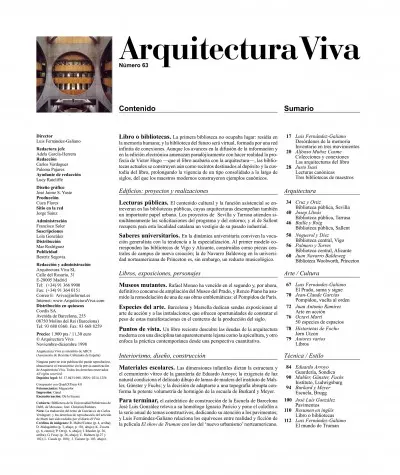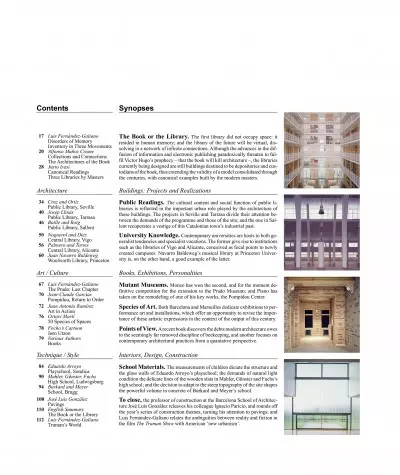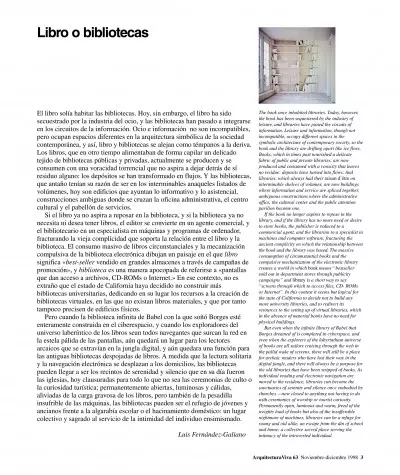Synopses
The Book or the Library. The first library did not occupy space: it resided in human memory; and the library of the future will be virtual, dissolving in a network of infinite connections. Although the advances in the diffusion of information and electronic publishing paradoxically threaten to fulfil Victor Hugo’s prophecy – that the book will kill architecture –, the libraries currently being designed are still buildings destined to be depositories and custodians of the book, thus extending the validity of a model consolidated through the centuries, with canonical examples built by the modern masters.
Contents
Luis Fernández-Galiano
Disorders of Memory
Inventory in Three Movements
Alfonso Muñoz Cosme
Collections and Connections
The Architectures of the Book
Justo Isasi
Canonical Readings
Three Libraries by Masters
Buildings: Projects and Realizations
Public Readings. The cultural content and social function of public libraries is reflected in the important urban role played by the architecture of these buildings. The projects in Seville and Tarrasa divide their attention between the demands of the programme and those of the site; and the one in Sallent recuperates a vestige of this Catalonian town’s industrial past.
Architecture
Cruz y Ortiz
Public Library, Seville
Josep Llinás
Public Library, Tarrasa
Batlle y Roig
Public Library, Sallent
University Knowledge. Contemporary universities are hosts to both generalist tendencies and specialist vocations. The former give rise to institutions such as the libraries of Vigo and Alicante, conceived as focal points to newly created campuses. Navarro Baldeweg’s musical library at Princeton University is, on the other hand, a good example of the latter. Noguerol y Díez
Central Library, Vigo
Palmero y Torres
Central Library, Alicante
Juan Navarro Baldeweg
Woolworth Library, Princeton
Books, Exhibitions, Personalities
Mutant Museums. Moneo has won the second, and for the moment definitive competition for the extension to the Prado Museum; and Piano has taken on the remodeling of one of his key works, the Pompidou Center.
Art / Culture
Luis Fernández-Galiano
The Prado: Last Chapter
Jean-Claude Garcias
Pompidou, Return to Order
Species of Art. Both Barcelona and Marseilles dedicate exhibitions to performance art and installations, which offer an opportunity to revise the importance of these artistic expressions in the context of the output of this century. Juan Antonio Ramírez
Art in Action
Octavi Martí
50 Species of SpacesPoints of View. A recent book discovers the debts modern architecture owes to the seemingly far removed discipline of beekeeping, and another focuses on contemporary architectural practices from a quantative perspective. Focho’s Cartoon
Jørn Utzon
Various Authors
Books
Interiors, Design, Construction
School Materials. The measurements of children dictate the structure and the glass walls of Eduardo Arroyo’s playschool; the demands of natural light condition the delicate lines of the wooden slats in Mahler, Günster and Fuchs’s high school; and the decision to adapt to the steep topography of the site shapes the powerful volume in concrete of Burkard and Meyer’s school.
Technique / Style
Eduardo Arroyo
Playschool, Sondica
Mahler, Günster, Fuchs
High School, Ludwigsburg
Burkard y Meyer
School, Brugg
To close, the professor of construction at the Barcelona School of Architecture José Luis González releaves his colleague Ignacio Paricio, and rounds off the year’s series of construction themes, turning his attention to pavings; and Luis Fernández-Galiano relates the ambiguities between reality and fiction in the film The Truman Show with American ‘new urbanism’. José Luis González
Pavings
English Summary
The Book or the Library
Luis Fernández-Galiano
Truman’s World
Luis Fernández-Galiano
The Book or the Library
The book once inhabited libraries. Today, however, the book has been sequestered by the industry of leisure, and libraries have joined the circuits of information. Leisure and information, though not incompatible, occupy different spaces in the symbolic architecture of contemporary society, so the book and the library are drifting apart like ice floes. Books, which in times past nourished a delicate fabric of public and private libraries, are now produced and consumed with a voracity that leaves no residue: deposits have turned into flows. And libraries, which always had their raison d'être on interminable shelves of volumes, are now buildings where information and service are spliced together, ambiguous constructions where the administrative office, the cultural center and the public attention pavilion become one.
If the book no longer aspires to repose in the library, and if the library has no more need or desire to store books, the publisher is reduced to a commercial agent, and the librarian to a specialist in machines and computer software, fracturing the ancient complicity on which the relationship between the book and the library was based. The massive consumption of circumstantial books and the compulsive mechanization of the electronic library creates a world in which book means “bestseller sold out in department stores through publicity campaigns” and library is a short way to say “screens through which to access files, CD- ROMs or Internet”. In this context it seems but logical for the state of California to decide not to build any more university libraries, and to redirect its resources to the setting up of virtual libraries, which in the absence of material books have no need for physical buildings.
But even when the infinite library of Babel that Borges dreamed of is completed in cyberspace, and even when the explorers of the labyrinthian universe of books are all sailors cruising through the web in the pallid wake of screens, there will still be a place for archaic readers who have lost their way in the digital jungle, and there will always be a purpose for the old libraries that have been stripped of books. As individual reading and electronic navigation are moved to the residence, libraries can become the sanctuaries of serenity and silence once embodied by churches —now closed to anything not having to do with ceremonies of worship or tourist curiosity. Permanently open, luminous and warm, freed of the weighty load of books but also of the insufferable nightmare of machines, libraries can be a refuge for young and old alike, an escape from the din of school and home: a collective sacred place serving the intimacy of the introverted individual.








